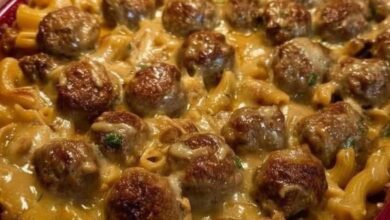Gnocco Fritto – The Irresistible Italian Fried Bread

Gnocco Fritto – The Irresistible Italian Fried Bread
Introduction
There’s something magical about the simplicity of Italian cooking, and Gnocco Fritto captures that magic perfectly. Crispy, golden, and airy on the outside, yet tender and fluffy within, these small fried doughs are a beloved staple from the Emilia-Romagna region of Italy. Whether enjoyed fresh from the fryer, paired with thin slices of prosciutto, or served alongside creamy cheese, Gnocco Fritto brings warmth and comfort to any table.
This humble yet elegant dish dates back centuries, born from the resourceful kitchens of Northern Italy. Originally made by farmers using simple pantry staples like flour, lard, and milk, Gnocco Fritto quickly became a cherished favorite across the region. Today, it remains a symbol of hospitality — a dish to share, savor, and celebrate with family and friends.
If you’re searching for a recipe that’s easy, satisfying, and authentically Italian, Gnocco Fritto is exactly what you need. It’s a culinary experience that balances texture, tradition, and irresistible flavor in every bite.
Why This Recipe Works
There’s a reason Gnocco Fritto has stood the test of time — it’s a perfect harmony of texture and flavor. This recipe works beautifully for several key reasons:
Manitoba Flour for Perfect Structure:
Using strong Manitoba flour ensures the dough has enough gluten strength to puff beautifully when fried. The result? Airy pillows that are light yet satisfyingly chewy.
Lard Adds Authentic Flavor:
Traditional Italian recipes rely on lard, not butter or oil, to achieve that rich, authentic taste and perfectly crisp texture. It gives Gnocco Fritto a subtle depth that vegetable oil alone can’t replicate.
Warm Water and Milk Combination:
This mix activates the yeast gently, creating a smooth, elastic dough that rises evenly. It also lends a delicate richness to the dough.
Proper Rest Time:
Allowing the dough to rest for two hours gives the yeast time to work its magic, developing both texture and flavor. This step ensures your Gnocco Fritto puffs up beautifully in the oil.
Frying Technique:
Frying at the right temperature—hot but not smoking—creates the signature golden crust while keeping the inside soft. The key is balance, and this recipe nails it every time.
In short, this version of Gnocco Fritto stays true to Italian tradition while guaranteeing consistent, professional results at home.
What You’ll Need For This Recipe
Before you start frying, gather these simple yet essential ingredients for your Gnocco Fritto:
Ingredients:
560 g (4 ½ cups) Manitoba flour – provides strength and elasticity
15 g (1 ¼ tablespoons) salt – for flavor balance
40 g (3 tablespoons) lard – traditional fat for richness and crispness
140 ml (½ cup) warm water – helps dissolve the yeast and form the dough
140 ml (½ cup) hot milk – adds tenderness and depth
15 g (2 tablespoons) fresh yeast – for perfect rise and airy texture
Frying oil – neutral oil like sunflower or peanut oil for frying
Equipment:
Mixing bowls
Rolling pin
Pizza cutter or sharp knife
Deep frying pan or pot
Paper towels for draining
These ingredients come together beautifully to create authentic Gnocco Fritto, just as you’d find in Emilia-Romagna.
How To Make This Recipe
Let’s dive into how to make the perfect batch of Gnocco Fritto. It’s surprisingly simple — just a few steps and a little patience are all it takes to create something extraordinary.
Step 1: Mix the Dry Ingredients
In a large mixing bowl, combine the Manitoba flour and salt. Add the lard and begin working it into the flour using your fingertips. You’re looking for a sandy, crumbly texture — this ensures the fat is evenly distributed.
Step 2: Activate the Yeast
In another bowl, combine warm water, hot milk, and fresh yeast. Stir until the yeast is completely dissolved. The liquid should feel warm but not hot to the touch — this encourages the yeast to activate properly without killing it.
Step 3: Combine Wet and Dry
Gradually pour the yeast mixture into the flour mixture while mixing. Knead the dough gently until all the ingredients come together. Continue kneading for about 10 minutes until the dough becomes smooth and elastic.
Step 4: Let the Dough Rise
Form the dough into a ball, place it in a lightly floured bowl, and cover it with a clean kitchen towel. Let it rest for about 2 hours, or until it doubles in size. This resting period is essential for creating that light, airy texture typical of Gnocco Fritto.
Step 5: Shape the Dough
Once the dough has risen, divide it into two equal parts. Using a rolling pin, roll each portion into a thin sheet (about 2–3 mm thick). Use a pizza cutter or knife to cut the dough into small rectangles or diamonds, roughly 5–6 cm wide.
Step 6: Fry to Perfection
Heat your frying oil to 170–180°C (340–355°F) in a deep pan. Gently slide a few pieces of dough into the oil at a time — don’t overcrowd the pan. Fry each piece for about 1 minute per side, until golden and puffed.
Step 7: Drain and Serve
Remove the fried dough with a slotted spoon and drain on paper towels. Serve warm for the best experience — this is when Gnocco Fritto is at its fluffiest and most aromatic.
Tips + Tricks & More For Recipe Success
To make sure your Gnocco Fritto turns out perfect every single time, here are a few expert tips and tricks:
Use the Right Flour:
Manitoba flour is ideal for this recipe. It gives your dough the strength to hold air and puff beautifully when fried.
Check Your Oil Temperature:
If the oil is too cold, the dough will absorb too much oil and turn greasy. Too hot, and it will brown too fast without puffing properly. Maintain a steady 170–180°C for golden perfection.
Roll Evenly:
Uniform thickness ensures even frying. Too thin and they’ll crisp too much; too thick and they won’t puff.
Don’t Skip the Rest:
The resting time is key to achieving that airy interior. Rushing it will lead to dense, heavy fritters.
Lard vs. Butter:
Stick with lard for traditional taste and texture. Butter changes the moisture content and may prevent proper puffing.
Serve Immediately:
Gnocco Fritto is best enjoyed fresh and hot. Once cooled, it loses some of its signature lightness.
Add Flavors (Optional):
For a fun twist, try adding herbs like rosemary or thyme to the dough — though purists will insist on keeping it plain!
Following these simple yet important details ensures you’ll always achieve flawless Gnocco Fritto worthy of any Italian nonna.
How To Serve
Gnocco Fritto is at its best when served warm, just moments after frying. Traditionally, it’s placed in a basket lined with a cloth to keep it warm and absorb any excess oil.
The beauty of Gnocco Fritto is its versatility. It can be served as a snack, appetizer, or even part of a full meal. In Emilia-Romagna, it’s often paired with salumi (cured meats like prosciutto di Parma, mortadella, or salami) and formaggi (cheeses such as gorgonzola, stracchino, or Parmigiano-Reggiano).
For an elegant touch, drizzle a little honey or fig jam over it before topping with cheese. The mix of savory and sweet flavors is simply divine.
Serving Suggestions
Here are a few creative ways to enjoy your Gnocco Fritto:
Classic Style:
Serve warm with a platter of Italian cured meats and cheeses — a perfect antipasto board.
With Soups and Stews:
Dip your Gnocco Fritto into thick vegetable soups or meaty stews for a comforting meal.
Sweet Variation:
Dust lightly with powdered sugar or drizzle with Nutella for a fun dessert version.
Brunch Idea:
Serve alongside scrambled eggs, smoked salmon, and fresh fruit for a luxurious brunch spread.
Party Favorite:
Make bite-sized Gnocco Fritto and serve them with dipping sauces — marinara, garlic aioli, or pesto.
Each variation offers a unique way to experience the delightful texture and flavor of this Italian treasure.
Time Breakdown
Prep Time: 25 minutes
Resting Time: 2 hours
Cooking Time: 15 minutes
Total Time: 2 hours 40 minutes
In under 3 hours, you’ll have golden, puffed, delicious Gnocco Fritto ready to serve and share.
Final Thoughts
Few dishes embody the heart of Italian home cooking like Gnocco Fritto. With its crispy exterior, soft interior, and simple ingredients, it’s proof that the best recipes don’t need to be complicated. Each bite brings warmth, nostalgia, and the unmistakable taste of tradition.
Whether you’re preparing it for a cozy family meal or as a show-stopping appetizer for guests, Gnocco Fritto will always impress. From the first golden puff to the last savory crunch, this dish invites you to slow down, share, and savor the moment — just like they do in Emilia-Romagna.
So roll up your sleeves, heat up that oil, and let the aroma of freshly fried dough fill your kitchen. Once you’ve made Gnocco Fritto, it’s sure to become a recipe you’ll treasure — and return to — again and again.



